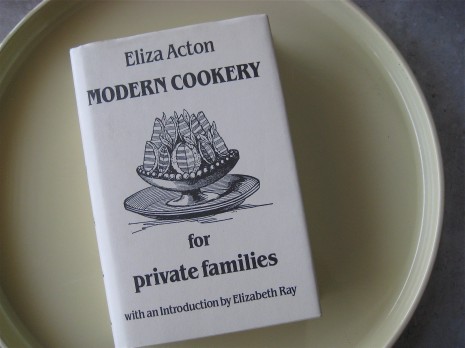ELIZA ACTON’S MODERN COOKERY
I never pass up an excuse to get horizontal and read a cookbook. So when I was asked to participate in a couple of panel discussions at an upcoming cookbook conference*, I accepted with alacrity. Then I ransacked our bookshelves, got comfortable … and became re-acquainted with some old favorites.
It was especially hard to tear myself away from what Elizabeth David called “the greatest cookery book in our language”— Modern Cookery for Private Families, written by Eliza Acton, of Tonbridge, Kent, and published in 1845. Written during the Industrial Revolution, it was one of the first cookbooks tailored for the small household and the rapidly expanding middle class.
Acton originated the recipe form we are familiar with today, with a list of ingredients (at the end of recipes instead of the beginning) in the order in which they are called for. She gives quantities of ingredients, estimates the time it takes to prepare and cook a dish, and includes introductory material that is still au courant. In the chapter on vegetables, she leads off with the fact that, “The quality of vegetables depends much both on the soil in which they are grown, and on the degree of care bestowed upon their culture; but if produced in ever so great perfection, their excellence will be entirely destroyed if they be badly cooked.”
The recipes are larded with interesting observations, helpful hints, and concise personal asides when she is particularly taken with a dish: To Dress Dandelions Like Spinach, or as a Salad (Very Wholesome); Carrots in Their Own Juice (A Simple but Excellent Receipt); Ox-Cheek Stuffed and Baked (Good, and Not Expensive); Mushrooms Au Beurre (Delicious).
Acton is often described as a Victorian spinster, but the introduction to my copy, above, rightly points out that she was born in 1799, well before the Queen herself. Consequently, the precision and pungency of her prose have far more in common with Jane Austen and other Regency writers than with Dickens and his crowd.
In a “French receipt” for cauliflower, she writes: “Cut the cauliflowers into small handsome tufts, and boil them until three parts done, drain them well, toss them for a moment in some thick melted butter or white sauce, and set them by to cool. When they are quite cold, dip them separately into the batter … fry them a light brown, arrange them neatly in a dish, and serve them very hot.”
Even if you’ve never picked up a cauliflower before, you know you are in the hands of a friendly, capable home cook—someone with intelligence and insight, someone who was actually in the kitchen. And that is why the book still sounds so fresh and accessible. Only someone who had taken the time to coax the best out of Buttered Apples (Excellent) would think to add, “Particular care must be taken to keep the apples entire; they should rather steam in gentle heat rather than boil.”
Acton was brilliant at writing what often causes you to stop and read a recipe in the first place: its title. Just a few well-chosen words are enough to give you a sense of a dish: A Good English Stew, A Less-Expensive Hare Soup, Gravy in Haste, Sweetbreads Simply Dressed, Excellent Portable Lemonade, A Birthday Syllabub.
She had especially good fun with puddings: The Welcome Guest’s Own Pudding, Small and Very Light Plum Pudding, The Curate’s Pudding, The Elegant Economist’s Pudding, and The Young Wife’s Pudding, which begins, “Break separately into a cup four perfectly sweet eggs…” “The Poor Author’s Pudding” stands in pointed contrast to “The Publisher’s Pudding,” which starts out by informing you that “This pudding can scarcely be made too rich.”
Acton’s way with words had led her to first try her hand at poetry. A collection published in 1826, which included the possible evidence of a broken engagement in the form of offerings such as “Take Back Thy Ring” and “Go, Cold and Fickle Trifler!,” sold modestly. Her publishers rejected her second volume, though, and suggested she write a household cookbook. She spent years gathering material and testing recipes, and Modern Cookery was an instant success, appearing in a number of revised editions until the end of the 19th century. I’m very fond of my edition, published by Southover Press in 1993, and last year Quadrille published a sparky new edition that will, I hope, appeal to a whole new generation interested in cooking honest, simple food to perfection. Now, that would be (Fabulous).
* A shamelessly self-promotional digression: Happily, the conference, organized in large part by food historian Andrew Smith and taking place this coming weekend here in New York City, is sold out. But, if you are so inclined, 10 panels on Friday and Saturday, February 10 and 11, will be webcast. So tune in, watch the panels, and tweet questions. All 28 panels will be filmed and posted on the same website a week or so after the conference. Click here for the broadcast schedule.
Posted: February 9th, 2012 under cookbooks, culinary history, favorite books.
Comments
Comment from admin
Time February 13, 2012 at 1:09 pm
There is also Eliza Acton’s “Elegant Economist,” published in Penguin’s “Great Food” series; it is pretty great, too!
Cheers,
Jane



Comment from Robin
Time February 13, 2012 at 12:04 pm
I am familiar with Mrs. Beeton and knew that she drew heavily on Acton, but I had never looked at Modern Cookery for Private Families. I love that she began as a poet. Can’t wait to delve into this! Thank you.